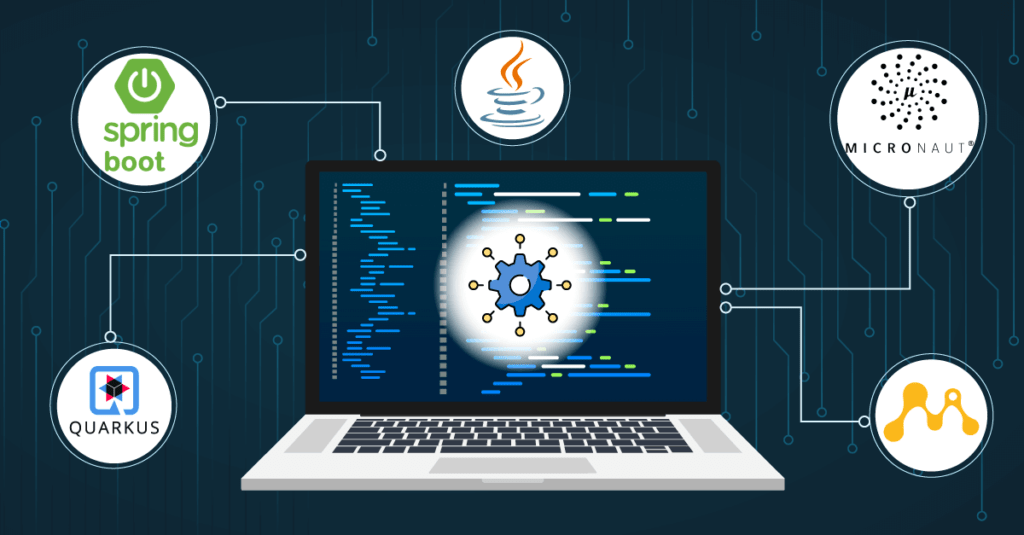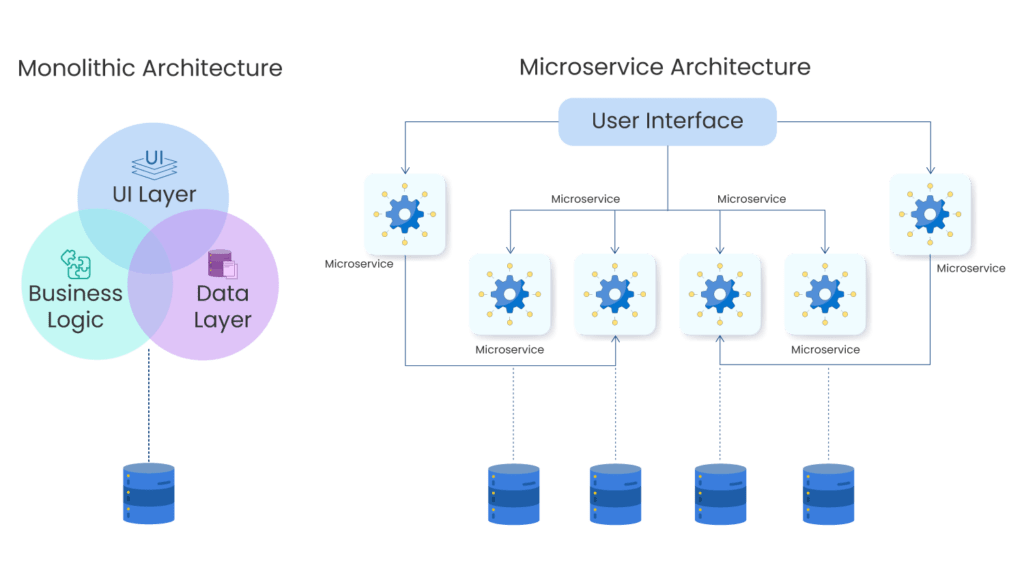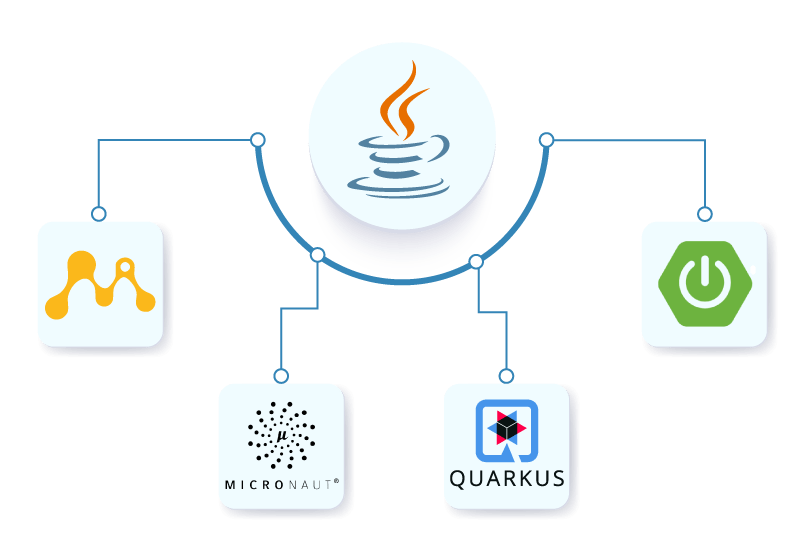Best Java Frameworks for Microservices App Development
The monolithic architecture was only a standard for application development for longer. In the late 2000s, Microservices came into the picture and are still trending nowadays. The number of searches for the “Microservices” word has doubled on Google over the last five years. Many high-profile companies have transitioned from monolithic to microservices. The Netflix company was a pioneer in this transition around 2009. Nowadays, tech giants like Uber, Spotify, Amazon and Twitter have adopted microservices.

Why Develop an Application in Microservices
Microservices architecture is used to build scalable, flexible and resilient applications. An application is built with small independent, loosely coupled services instead of one extensive monolithic application. Each service can develop, deploy and scale up without disrupting other services. By creating multiple services, a bottleneck to a central database is avoided. Also, Business Capabilities are improved by enabling CI/CD and liberty to choose a technology stack for a service.

Companies choose Microservices architecture over Monolithic because it is time-efficient, reducing costs. Below are the summarised benefits,
- Time-efficient: Ability to make development and deployment lifecycles shorten.
- Cost-efficient: A cost of scaling is less than a monolithic application.
- Language Neutral: A service can be created with different programming languages, tech tools, and software environments based on needs.
- Agile: An individual team can work on an individual service which makes the team responsible for specific business deliverables.
- Independent: A service is built around business capabilities and can be developed and deployed independently.
- Reusable: An existing service or module can be reused instead of developing new functionality from scratch.
“Microservices are by no means a silver bullet, but not a less than that too”. It has solved several problems for growing software and companies.
Advantages of Building Microservices with Java
Microservices can be developed in any programming language, but selecting one depends on several factors, including technical, ecosystem and economic considerations. JetBrains Survey says the three most popular programming languages for microservices are Java (34%), Python (14%) and Go (12%). Following are the advantages of building microservices with Java.
- Several Frameworks – We need to do the setup and configuration process to start with.
- Large Community – Java has extensive community support with various resources, libraries, and frameworks due to a large developer community that can help troubleshoot and resolve issues.
- Java has a long history of successful enterprise, web, mobile, Big Data, AI, and Cloud applications. Java is a well-established, mature, and well-suited technology for building robust and reliable microservices.
- Annotation syntax – A key factor to make it easy to understand and developer friendly. It has JPA and JAX-RS for APIs, Contexts & Dependency Injection, and lifecycle.
- Monolith to Microservice – Java has a user interface, model components, service discovery, and connectivity to backend resources under a single, isolated, and independently deployed microservice.
“Nobody ever got fired for selecting Java for microservices.”
Factors to Consider when Choosing a Microservices Framework
Once we create an application with microservice architecture, the next step is to select the best framework. A framework should be a good fit for business capabilities, functionalities and resources available.
Check the following factors:
- A framework that can scale as per changes in business requirements.
- A framework that has Tools and IDEs. It should increase the developer’s productivity.
- A framework that has required APIs and interfaces with built-in design patterns for application development. It should also support asynchronous communication.
- A framework that has community support, frequent releases, and new features.
- A framework with support for application metrics, health checks, and analytics.
- A framework that has support for creating customized components for individual services.
- A framework that has support for CI/CD tools integration and automation.
- A framework that has support for independent deployment in a distributed system.
- A framework that has support for multiple database integration.
- A framework that has support for Unit and Integration testing.
Java Microservices Frameworks

1. Spring Boot
It is a popular and powerful framework used to build microservices in Java. It offers auto-configuration and various extension projects like JPA, JDBC, etc. It helps to develop large-scale applications with components. It also has Spring Cloud to maintain network traffic, discovery service and API gateway. It is easy to deploy on Docker and Kubernetes. It is used to build REST and SOAP APIs.
One of the disadvantages of Spring Boot is that developer has no control over binary file size. Unnecessary dependencies are added to binary files due to their design. Also, the Autoconfiguration feature enables several unnecessary features which access system resources to run.
2. Quarkus
It is a full-stack Kubernetes-native Java framework that uses GraalVM. A GraalVM reduces startup overhead by fast boot time. It is based on Kubernetes and serverless environments and is used for implementing distributed application architectures. It is mainly used for creating fast and reactive Microservices.
One of the disadvantages of Quarkus is that more developers and community support are needed. Also, development can be slower and cheaper as compared to Spring Boot.
3. Micronaut
It is a complete stack microservices framework for building modular, easily testable microservice and serverless applications. Micronaut uses compile-time data to implement dependency injection, whereas Spring relies on runtime reflection and proxies. It also provides reduced memory consumption.
One of the disadvantages of Micronaut is that it has fewer ways to handle configuration through properties. Also, it supports Caffeine and Redis only for Caching. It also has fewer options to monitor applications as compared to Spring.
4. MicroProfile
It is a framework that optimizes Java Enterprise for Microservice architecture created by Eclipse. It provides vendor-neutral specifications for creating Microservice Architecture. Companies like IBM, Red Hat and Oracle have backed the specification. It has Open tracing, Fault tolerance and Metrics feature required to solve microservices architecture challenges.
One of the disadvantages of MicroProfile is that deploying microservers in the Kubernetes environment is challenging.
Conclusion
Microservice architecture is used to create complex applications that can scale up and be flexible. We can benefit from the Architectural approach and available Java resources if we select Java and its framework. Despite any framework selection, have your tools ready to successfully execute and support the development and deployment of microservices architecture.




